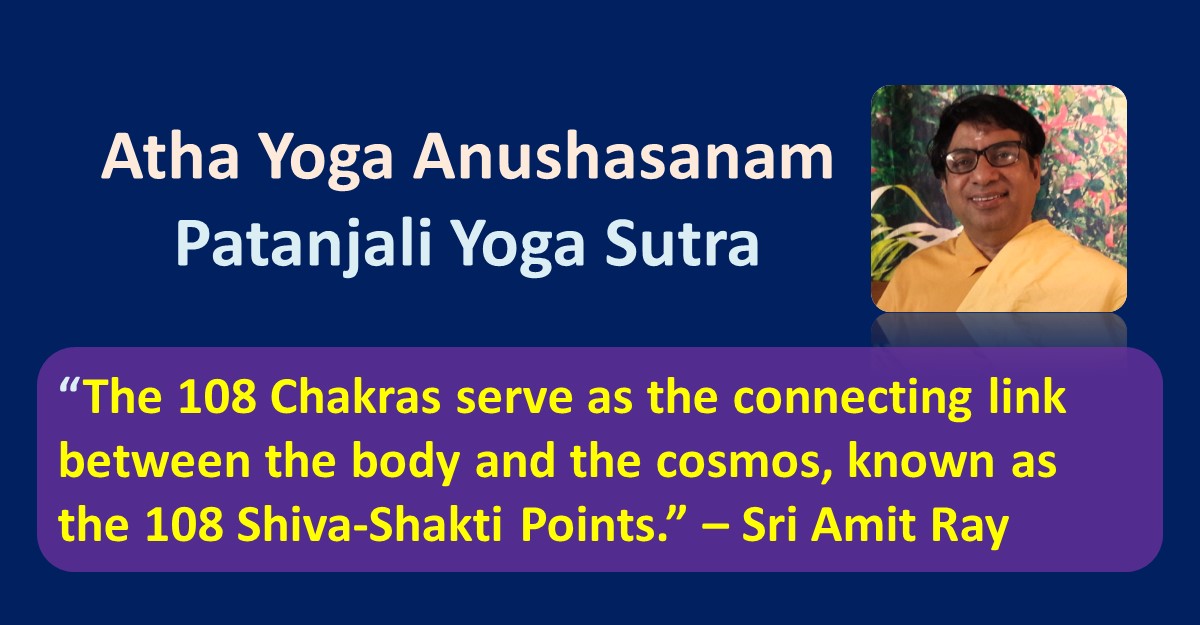In the profound tradition of Sri Amit Ray’s 108 chakra system, yoga unfolds as the art of harmonizing and balancing the dynamics of the two complementary forces of Shiva and Shakti, both at the individual and cosmic levels. The aphorism “Atha Yoga Anushasanam,” which opens the Patanjali Yoga Sutra, carries profound significance when considered alongside the hexagram’s representation of the 108 heavenly relationships between Shiva (Father, Son, and Holy Spirit) and Shakti (Mother, Daughter, and Holy Soul). This sloka is also an invitation to establish a connection between the heavenly macrocosmic and the individual microcosmic realms.

Commonly translated as “Now, the teaching of yoga begins,” this aphorism serves as the gateway to the realm of yoga practice. It holds the timeless essence that yoga is not confined to a particular era, religion, or culture; rather, it is a perpetual journey accessible to all seekers throughout all periods of existence.
In the context of how the hexagram shows the connections between divine forces, “Atha Yoga Anushasanam” takes on a deeper meaning, signifying the start of a deep spiritual journey towards realising how these divine forces are all connected. This journey transcends time and is a timeless pursuit that beckons the seeker to explore the profound unity and harmony inherent in the fabric of existence.
Mental Purification
The Patanjali Yoga Sutra, with its emphasis mental purification, and stability, presents a profound roadmap for inner transformation and self-realization within the realm of yogic philosophy. This ancient system, rooted in Hinduism, transcends cultural and religious boundaries, resonating with spiritual seekers from diverse backgrounds, including those within the Christian faith.
The 108 chakras and the yogic journey
In the world of yoga, the journey of the soul is illuminated by the awakening, deep meditation and the alignment of the 108 chakras. These energy centers serve as conduits for spiritual growth, reflecting the core principles of yoga’s universal wisdom. The chakras, though deeply rooted in yoga tradition, offer a language and framework that transcends religious affiliations, making them accessible and relevant to individuals from all walks of life, including Christians. On the Christian path, the symbolism of the Father, Mother, and the Holy Spirit mirrors and complements key aspects of the yogic journey. Balancing the 108 chakras is the key to Chitta Vritti Nirodh.
Yoga with Love and Compassion
According to Sri Amit Ray, love, compassion, and inclusiveness are the heart of yoga. This sloka is the starting point for that journey.
The Father represents the unifying force, akin to the highest chakra, Sahasrara, which symbolizes pure consciousness and unity with the divine. This divine unity transcends the confines of religion, emphasizing the universality of the human quest for spiritual connection.
Just as God the Mother embodies love and compassion, the heart chakra serves as a bridge for individuals of all faiths to explore the boundless capacity for love and empathy within themselves.
Furthermore, the concept of God the Holy Spirit emerges as a dynamic and transformative presence, beautifully echoing the essence of “Atha Yoga Anushasanam.” This yogic aphorism signifies the commencement of a spiritual journey, and the Holy Spirit’s role in guiding and empowering believers harmonizes seamlessly with the yogic path of inner transformation and awakening, echoing the idea that the pursuit of yoga is a timeless endeavor accessible to seekers across all eras.
Interconnectedness and Unity of Yoga
Within this context, the figure of Sophia, the Spirit of Wisdom, as revered in the Old Testament, takes on a significant role. In Old Testament scriptures, Wisdom is symbolically depicted as a female figure and poetically portrayed as the bride in the Song of Songs. This personification of Wisdom mirrors the essence of “Atha Yoga Anushasanam,” as it encourages the expansion of consciousness and a deeper connection with the universe. It urges individuals to embrace higher insights and spiritual evolution, ultimately leading to unity with the divine.
Moreover, the hexagram’s intricate symbolism, which represents the heavenly relationships between the Father, Son, and Holy Spirit on one side, and the Mother, Daughter, and Holy Soul on the other, is intrinsically linked to the message of “Atha Yoga Anushasanam.” It serves as a visual representation of the interconnectedness and unity of these celestial forces. This symbolism reinforces the shared pursuit of spiritual growth and communion with the divine, reminding us that the yogic journey transcends religious and cultural boundaries, resonating with seekers from various spiritual backgrounds.
Learn more on :Yogas Chitta Vritti Nirodha Patanjali’s Yoga Sutra (1.2)
Meanings of Atha Yoga Anushasanam
The phrase “Atha Yoga Anushasanam” from the Patanjali Yoga Sutra 1.1, carries profound meanings. It signifies the initiation of the yoga journey, inviting seekers to embrace the practice of yoga as a timeless pursuit. “Atha” emphasizes the present moment, highlighting that the path to yoga begins now, in the present. “Yoga” encompasses the holistic union of mind, body, and spirit. “Anushasanam” implies guidance and discipline, emphasizing the systematic and disciplined approach required for spiritual growth. Together, this phrase signifies a call to embark on the transformative journey of self-realization and inner balance, where the seeker connects with the timeless wisdom of yoga to attain spiritual harmony.